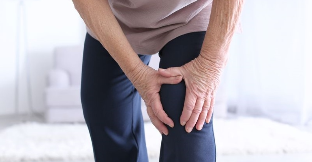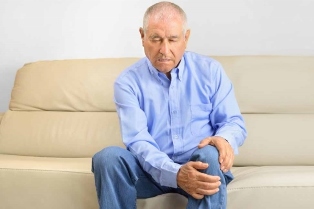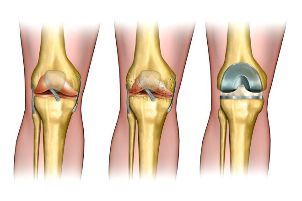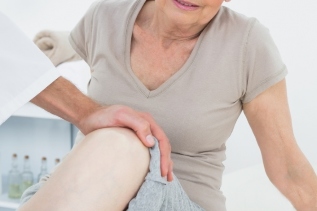Osteoarthritis of the knee (gonarthrosis) is the defeat of the knee, in their majority, not of an inflammatory nature, which leads to the wear and tear of articular cartilage of the middle layer of the knee and, over time, to the destruction of the cartilage, the deformation of the knee and limitation of mobility. Therefore, it is important to be able to recognize the disease and know how and what it is about.

Osteoarthritis of the knee (called gonartrosisom – from the ancient Greek "goni" – of the knee) is a progressive, and on the other hand, degenerative of the defeat of the cartilage that lines the joint surface, which leads to the alteration of their work and armbar sensations.
Causes of the onset of osteoarthritis of knee
Knee osteoarthritis is divided into primary (evolved independently), and the secondary, which occurs as a result of other diseases of the knee joint.
Main
Primary osteoarthritis (genuinny) is osteoarthritis, which begins without noticing the causes and affects undisturbed of articular guided the cartilage in many joints at the same time. It is most often seen in people older than 40 years. It has also been shown that women are more men suffer from osteoarthritis) of the knee joints and the joints of the wrists.
Why does it occur primary osteoarthritis, until the end is unknown, but it is likely that he was lead to metabolic disorders. This causes changes in the biochemical reactions that occur in the cartilage tissue. With time, it destroys, degenerates and accumulates salt. The surface of the knee joint varies with the structure of the cartilage and, in consequence, of the tribe accumulates fluid and appears as a cyst becker.
Secondary
It is the result of the disease or damage of the joints, by their clinical manifestations does not differ from that of the main. It develops in practically all of the joints.
Secondary osteoarthritis occurs due to the following reasons:
- the inflammatory process, immune or infections source;
- dysplasia or traumatic injuries to the meniscus of the knee (miniscope);
- fractures of guided intra-articular bones which form the knee joint;
- rheumatoid arthritis;
- tumors of the bones;
- ankylose spondylitis;
- the osteoarthritis, occur when paget's disease.
The symptoms of the

Some of the symptoms of osteoarthritis are the following:
- the pain in the feet, knees, hips, low back;
- the stiffness, the stiffness and the cracking of the joints;
- the pain after sleeping or a long time in the same position;
- swelling of the joints;
- pains of a changing climate;
- pain in the joints after the load;
- injuries: fractures, dislocations, and injuries of the menisci;
- increase of the load;
- overweight and obesity;
- weak ligamentous apparatus – disordered ligaments;
- the violation of the processes of change in the body;
- factors of stress.
The deformation of the joint
The deformation of the joint is the change of the shape of the joint caused by the displacement of the ends of the bones that articulate to the dislocacin, the development of the knee injury tissue growths. Most often deformation suffer the joints of the hands, feet, thighs.
The deformation of the joints in general will be the result of a complex of the types of violations in periarticular, bone, or cartilage tissues, where they have the property to accumulate atypical in this location, and concentration of the substance.
The result of the deformation of the joints often leads to fusion of the joints, bony expansion, subluxations of the joints and damages the muscle-ligamentous apparatus.
With regard to this concomitant reasons of gonartrosisy applicable to symptomatic treatment, however, an approach focused on the solution of the disease in general, shows a more effective and prevents relapse.
The diagnosis of the deformation of the joints occurs regardless of the general approach of the diagnosis. It is on the basis of the assessment and their respective conclusions. The research objective of the joints allows to determine the setting, swelling, pain, the sensation and the movement, the volume of assets and liabilities of the movements in the joints and changes in the skin and the subcutaneous tissue in the area of the joints.
Limitation of mobility, joint with guided
Distinguish different degrees of limitation of motion: lung, barely perceptible violate a normal amount of movement, up to complete loss of mobility.
According to the degree of limitation of mobility, joint with guided are distinguishable:
- Ankylosis – complete immobility of the patient with surgery.
- Stiffness – saves only a small amount of movements. For example, the small rocking motion. When we conduct a study of the rigidity must be distinguished from ankylosis.
- Contracture – limitation of mobility lasting and important, but, however, there is still a certain amount of motion in the joint. Diagnose the amount of movement is possible with a simple protractor.

The degree of osteoarthritis of the knee
The first. In this case, the disease is characterized by small pain when doing active movements. May accumulate fluid in the cavity of the joint, which leads to the formation of cysts baker. The pain occurs during the movement, but soon passed in a state of rest. The cartilage tissue is damaged, but outwardly the deformation of the joint is imperceptible.
The second. A narrowing of the joint cleft, the cartilage tissue is damaged to a great extent. In the image received in the course of the x-ray, you can observe the thickening of the bones. Acute pain accompanied by any motion in the involved knee joint. At rest, the discomfort will persist, but then appear again. The headaches are added to the characteristic snapping in the commission of extensor movements.
Third. Seats the cartilage of the fabric thins, are bare areas of bone. In the x-ray visible of a large number of osteophytes – salt deposits in the cavity of the joint. In addition, there can be detected free of the body.
Potential complications, and consequences of osteoarthritis of the knee
Osteoarthritis of the knee is a degenerative disease, that with the time goes on. Joint pain and stiffness are so strong, that the patient is not in a position to deal with the issues of the day. Some people lose the ability to work, when osteoarthritis reaches a stage in which the physician recommends that only an operation of replacement of joints.
If you ignore the symptoms of the disease, and no timely treatment, the possibility of complications is very high.
To the possible consequences of execution of osteoarthritis are:
- critique of the deformation of the joint, of its complete destruction.
- the world of the motor limitations of opportunities;
- the occurrence of intervertebral hernias;
- the decline in the quality of life, loss of capacity for work.
What doctor deals with the treatment?
This may be your doctor, orthopedic surgeon. As the necessity is prescribed by the consulting rheumatologist. The doctor rheumatologist will assess You, will establish an accurate diagnosis, to define the joints will be amazed. It will designate the laboratory and diagnostic techniques.
Only with the help of a full review of specialist will be able to answer the question: at what stage of gonartrosisy the patient and what is the treatment for you should.
If there is co-morbidity in spinal post requires the consultation of a neurologist and vertebrologist. These professionals prescribing rehabilitation treatment, which resolves the pain syndrome for the account of the infringement of the nerve fiber in the intervertebral discs.

The diagnosis
The defeat of the joint, reminiscent of arthritis, occur when many other diseases, and ignorant people often are mistaken in the definition of the disease. Therefore, in any case, do not attempt to install the diagnosis by itself.
A survey
Of diagnostic X-rays is the most well-known and significant, the method for its simplicity, availability and high informality. The catch is they are normally in two projections, lateral and straight, but if necessary, you can use different specific placement.
Ultrasound is considered to be quite promising direction, which allows the detection of liquid, in order to evaluate the pathologies of the soft tissues, as well as to visualize the cartilage and the joints of the surface. The advantages of this method before the x-ray refers to the possibility of changing the position of the sensor, as well as the lack of need for strict positioning of the patient to obtain a standard projections.
The mri and ct scan provide a wealth of information, as well as the possibility of obtaining a three-dimensional image of the studied area.
Laboratory tests
When knee osteoarthritis pathological changes occur mainly in the joint with guided cartilage, as well as in subchondral bone, synovial shell, other soft tissues of the joint. Because the features directly explore these structures are limited, the most important sources for the extraction of biomarkers are the blood, urine and fluid.
In the majority of cases, sufferers of osteoarthritis) of the knee there are no changes in the analysis of blood and urine, except in cases of synovitis with great effusion, when it occurs the increase of the esr, hypergammaglobulinemia, increase of level of the indicators of the acute phase – pcr, fibrinogen, and others, in the study of synovial fluid in significant differences from the normal of the do not identify.
In recent years, carried out intensive search for possible biological markers (bm), the degradation and the repair of the tissues of the joints (mainly of cartilage and bone). Bm reflect the dynamic changes, serve as predictors of forecast of knee osteoarthritis and the markers of effective pathogenetic treatment. The opening of new and more in-depth study of the known bm will grow to better understand the mechanisms of the pathogenesis of osteoarthritis.
However, the main task of the use of biological markers of cartilage metabolism – evaluation of the chondroprotective properties of drugs and the monitoring of the treatment of medicines that belongs to a group of "disease-modifying".
The treatment of osteoarthritis of the knee
The treatment of osteoarthritis, to put it mildly, is not an easy task. Therefore, before You previous to begin their arduous struggle against this disease, be sure to make a good doctor, to be surveyed next to him and together with him we develop a treatment plan.

Medications
The most often prescribed medication to relieve the inflammation and pain from osteoarthritis of the knee is an anti-inflammatory non-steroidal non-steroidal in nature. Effective medications in inflammatory processes, accompanied by synovitis. In addition, these medications relieve the pain. However, they do not cure the disease.
When taking anti-inflammatory drugs anti-inflammatory not worth to follow all recommendations of your doctor, as these drugs have an impressive series of side effects, especially during long hours of your application.
Chondroprotectors is a class of drugs that are retrieved from the cartilage, shaving the fabric. When you receive chondroprotectors it is worth bearing in mind that these medications are effective for the combined treatment of the disease.
Vasodilator drugs are also assigned to an integrated approach to treatment of osteoarthritis. Through them, you can retrieve the circulation of blood in the joint, as well as relieve spasms of the small vessels.
As a painkiller it is most often used in ointments or compresses with that warming effect. When you need a quick relief, which can be shown guided intra-articular injection of corticosteroid hormones.
The surgery
Lumbar puncture (minimally invasive intervention). This method is applicable for the diagnosis of the disease. In the capsule joint with guided injected the needle, removing part of liquid. This allows to obtain the material for the analysis, the reduction of the burden of the capsule, if necessary, enter the corticosteroids directly at the site of inflammation.
Arthroscopy. Represents the introduction of a special device the arthroscope through the incision in the skin. The method allows to carefully examine the joint as well as eliminate those that had separated fragments of cartilage, eliminating the cause of the inflammatory process and the pain.
Periarticular osteotomy. The essence of the method consists of the presentation of the bones with subsequent confirmation of another angle. The operation allows to reduce the load on the joint and eliminate the pain in the long term. Despite its effectiveness, this type of surgery is applied less frequently, too much load on the body of a patient and long-term rehabilitation.
The arthroplasty. In cases in which other treatments do not work, and the illness is completely or almost completely destroyed the joints, replace a prosthesis of plastic, metal or ceramic.
The total knee replacement of heavy and expensive, requires a long rehabilitation. Many of the patients for several months after the surgical intervention, riddled with pain. However, this method is often the only alternative to the immobility of the sick. The service life of the modern prosthesis reaches to twenty years, and during all these years, the patient can live a full life.

The recommended diet
The diet necessary in the first place, in order to control their weight. It has been shown that osteoarthritis is more often develops and is more tolerated only in overweight people, thus:
- limit your consumption of alcohol, fatty foods, semi-finished products;
- to control the mode of power supply;
- reduce the amount of salt intake;
- reduce the amount of sweets;
- eat more vegetables and fruit (preferably seasonal).
Measures of prevention of osteoarthritis
The main activities to prevent the development of knee osteoarthritis are:
- the reduction of excess weight;
- the increase of motor activity;
- a proper nutrition;
- the compliance of the principles of HLS.
A healthy lifestyle will strengthen Your body, improve the state of cartilage, joints and bones. You must stop drinking and smoking. At the time of doing outdoor activities, experience less stress and experiences, the more the good mood and the positive.
Osteoarthritis is a disease that does not recover completely, however, its development can be stopped, if the time to pay attention to the state of your health and begin the treatment. The therapy can reduce, or even completely eliminate some of the symptoms that greatly facilitate the life of a sick person.
















